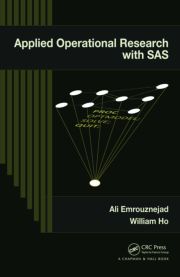Tutorial
1 – Abstract
Data envelopment analysis (DEA) is a linear programming based technique for measuring the relative performance of organisational units where the presence of multiple inputs and outputs makes comparisons difficult. This tutorial paper introduces the technique and uses an example to show how relative efficiencies can be determined and targets for inefficient units set. The paper …
2 – Introduction
There is an increasing concern with measuring and comparing the efficiency of organisational units such as local authority departments, schools, hospitals, shops, bank branches and similar instances where there is a relatively homogeneous set of units. The usual measure of efficiency, i.e.: is often inadequate due to the existence of multiple inputs and …
3 – Relative efficiency measurement
The measurement of relative efficiency where there are multiple possibly incommensurate inputs and outputs was addressed by Farrell and developed by Farrell and Fieldhouse(2), focusing on the construction of a hypothetical efficient unit, as a weighted average of efficient units, to act as a comparator for an inefficient unit. A common measure for relative efficiency …
4 – Weights to determine relative efficiency
Charnes, Cooper and Rhodes(3) recognised the difficulty in seeking a common set of weights to determine relative efficiency. They recognised the legitimacy of the proposal that units might value inputs and outputs differently and therefore adopt different weights, and proposed that each unit should be allowed to adopt a set of weights which shows it …
5 – Solutions to the DEA model
The efficiency of the target unit in a set can be obtained by solving M3. The solution to this LP provides a measure of the relative efficiency of the target unit and the weights leading to that efficiency. These weights are the most favourable ones from the point of view of the target unit. To …
6 – Graphical representation
Figure l shows a set of units P1, P2,… P6 with each unit consuming the same amount of a single resource and producing different amounts of outputs, y1 and y2 as shown. For a given amount of resource input, units providing greater amounts of the outputs will be the efficient ones. Applying the DEA approach …
7 – The dual DEA model
For any linear program (LP) it is possible to formulate a partner LP using the same data, and the solution to either the original LP (the primal) or the partner (the dual) provides the same information about the problem being modelled. DEA is no exception to this. The dual model is constructed by assigning a …
8 – Issues in DEA
The concern with the DEA approach is that by a judicious choice of weights a high proportion of units in the set will turn out to be efficient and DEA will thus have little discriminatory power. The first thing to note is that a unit which has the highest ratio of one of the outputs …
9 – Conclusions
DEA is a novel approach to relative efficiency measurement where there are multiple incommensurate inputs and outputs. If a suitable set of measures can be defined DEA provides an efficiency measure not relying on the application of a common weighting of the inputs and outputs. Additionally the method identifies peer units and targets for inefficient …
References
1. FARRELL M.J. (1957) The measurement of productive efficiency, J.R. Statis. Soc. Series A 120, 253-281. 2. FARRELL M.J. and FIELDHOUSE M. (1962) Estimating efficient production functions under increasing returns to scale, J.R. Statis. Soc. Series A 125, 252-267. 3. CHARNES A., COOPER W.W. and RHODES E. (1978) Measuring the efficiency of decision making units, …
















